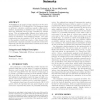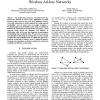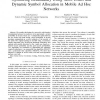1083 search results - page 103 / 217 » Performance of Underwater Ad-Hoc Networks |
PEWASUN
2004
ACM
15 years 3 months ago
2004
ACM
An M/MMGI/1/K queuing model is developed for the analysis of IEEE 802.11 DCF using RTS/CTS. Results are based on arbitrary contention conditions, namely, collision probabilities, ...
101
click to vote
INFOCOM
2009
IEEE
15 years 4 months ago
2009
IEEE
— The proliferation of wireless and mobile devices has fostered the demand of context aware applications, in which location is often viewed as one of the most significant context...
CISS
2008
IEEE
15 years 4 months ago
2008
IEEE
—We consider the design of a network in which packet transmissions between two nodes are to be guaranteed a certain probability of success. There are N independent paths between ...
105
click to vote
VTC
2007
IEEE
15 years 4 months ago
2007
IEEE
— This paper discusses a joint decentralized clustering and ranging algorithm for wireless ad-hoc sensor networks. Each sensor uses a random waiting timer and local criteria to d...
122
click to vote
HICSS
2003
IEEE
15 years 3 months ago
2003
IEEE
Scatternet formation must be addressed before any ad hoc network protocol can be run over Bluetooth. This is due to the frequency hop nature and piconet unit of Bluetooth. In this...



